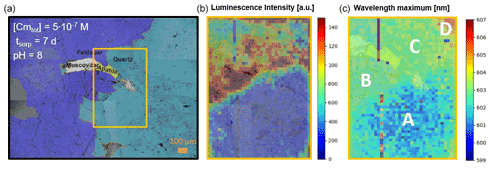Spatially resolved sorption of Cm(III) on crystalline rock: influence of surface roughness and mineralogy
Many countries will use deep geological repositories to dispose of highly active nuclear waste. Crystalline rock is a potential host rock because of its strong geotechnical stability, low permeability and low solubility; however, its inherent mineralogy is heterogeneous, consisting of a wide set of minerals in varying amounts. Therefore, there is a need for using sophisticated techniques that allow spatial resolution to characterize the nanostructure of such crystalline rock surfaces and the speciation of the actinides therein. As a representative for trivalent actinides, such as Am(III), Np(III), and Pu(III), which are expected to be present due to the reducing conditions encountered in a deep geological repository, we have chosen the actinide Cm(III). Cm(III) possesses excellent luminescence properties, which allows us to not only examine the sorption uptake but also the speciation of Cm(III) on the surface.
We combined spatially resolved investigation techniques, such as vertical scanning interferometry, calibrated autoradiography, and Raman microscopy coupled to micro-focus time-resolved laser-induced luminescence spectroscopy (µTRLFS) (Molodtsov et al., 2019). Thus, we were able to correlate mineralogy, surface roughness, and grain boundary effects with radionuclide speciation, allowing us to identify important radionuclide retention processes and parameters (see Fig. 1).
Investigations focused on granite from Eibenstock (Germany) and migmatised gneiss from Bukov (Czech Republic). Cm(III) sorption on the rock's constituting minerals – primarily feldspar, mica and quartz – was analyzed quantitatively and qualitatively. We observed that Cm(III) sorption uptake and speciation depends not only on the mineral phase but also the surface roughness (Demnitz et al., 2021). An increasing surface roughness leads to higher sorption uptake and a stronger coordination of the sorbed Cm(III). On the same mineral grains sorption differed significantly depending if an area exhibits a low or high surface roughness. In the case that one mineral phase dominates the sorption process, sorption of Cm(III) on other mineral phases will only occur at strong binding sites, typically where surface roughness is high. Areas of feldspar and quartz with high surface roughness additionally showed the formation of sorption species with particularly high sorption strength that could either be interpreted as Cm(III) incorporation species or ternary complexes on the mineral surface (Demnitz et al., 2021).
We conclude that in addition to mineral composition, surface roughness needs to be adequately considered to describe interfacial speciation of contaminants and respective retention patterns for the safety assessments of nuclear waste repositories.
Viele Länder werden geologische Tiefenlager für die Entsorgung ihrer hochradioaktiven Abfälle nutzen. Kristallines Gestein stellt wegen seiner ausgeprägten geotechnischen Stabilität, geringen Durchlässigkeit und geringen Löslichkeit ein potenzielles Wirtsgestein dar. Seine inhärente Mineralogie ist jedoch heterogen, denn sie setzt sich aus einem großen Spektrum von Mineralien in variierenden Mengenverhältnissen zusammen. Deshalb besteht die Notwendigkeit zum Einsatz anspruchsvoller Techniken, die eine ortsaufgelöste Untersuchung ermöglichen, um die Nanostruktur derartiger kristalliner Gesteinsoberflächen und die Speziation der Aktinide darauf zu charakterisieren. Als einen Vertreter der trivalenten Aktinide, zu denen auch Am(III), Np(III) und Pu(III) angehören, die aufgrund der reduzierenden Bedingungen in einem geologischen Tiefenlager in ihrer dreiwertigen Form vorliegen werden, wählten die Autoren das Aktinid Cm(III). Cm(III) besitzt ausgezeichnete Lumineszenzeigenschaften, die es ermöglichen, nicht nur die Aufnahme durch Sorption, sondern auch die Speziation von Cm(III) auf der Oberfläche zu untersuchen.
Dazu kombinierten die Autoren räumlich aufgelöste Untersuchungstechniken wie die vertikale Scanning-Interferometrie, die kalibrierte Autoradiographie und die Raman-Mikroskopie in Kopplung mit µTRLFS (mikrofokussierte zeitaufgelöste laserinduzierte Lumineszenzspektroskopie; Molodtsov et al., 2019). Somit waren sie in der Lage, Mineralogie, Oberflächenrauheit und Korngrenzeneffekte mit der Radionuklidspeziation in Beziehung zu setzen, was die Identifizierung wichtiger Radionuklidretentionsprozesse und -parameter ermöglichte (Abb. 1)
Der Fokus der Untersuchungen lag auf Eibenstocker Granit (Deutschland) und migmatisiertem Gneis aus Bukov (Tschechische Republik). Die Cm(III)-Sorption an den Mineralien, aus denen das Gestein besteht – in erster Linie Feldspat, Glimmer und Quarz –, wurde quantitativ und qualitativ analysiert. Die Autoren stellten fest, dass die Aufnahme durch Sorption und Speziation von Cm(III) durch Sorption nicht nur von der Mineralphase, sondern auch von der Oberflächenrauheit abhängig ist (Demnitz et al., 2021). Eine zunehmende Oberflächenrauheit führt zu einer höheren Sorptionsmenge und einer stärkeren Koordination des sorbierten Cm(III). Auf den gleichen Mineralkörnern unterschied sich die Sorption erheblich, je nachdem, ob ein Bereich eine geringe oder eine hohe Oberflächenrauheit aufwies. In dem Fall, dass eine Mineralphase den Sorptionsprozess dominiert, erfolgt die Sorption von Cm(III) an andere Mineralphasen nur an starken Bindungsstellen, typischerweise dort, wo die Oberflächenrauheit hoch ist. Bereiche mit Feldspat und Quarz mit hoher Oberflächenrauheit zeigten darüber hinaus eine Bildung von Sorptionsspezies mit besonders hoher Sorptionsstärke auf, die entweder als Cm(III)-Inkorporationsspezies oder als ternäre Komplexe an der Mineraloberfläche interpretiert werden könnten (Demnitz et al., 2021).
Die Autoren kommen zu der Schlussfolgerung, dass neben der Mineralzusammensetzung auch die Oberflächenrauheit angemessen berücksichtigt werden muss, um die Speziation von Kontaminanten an Grenzflächen und die jeweiligen Retentionsmuster für die Sicherheitsbewertung von Endlagern für nukleare Abfälle zu beschreiben.





